Gurney-Weslake V8
brought to you by: Dave Williams
This page: www.bacomatic.org/~dw/fordv8/gurney/gurney.htm
Main page: http://www.bacomatic.org/~dw/index.htm
Last Updated: 16 Jul 2003
Author: Dave Williams; dlwilliams=aristotle=net
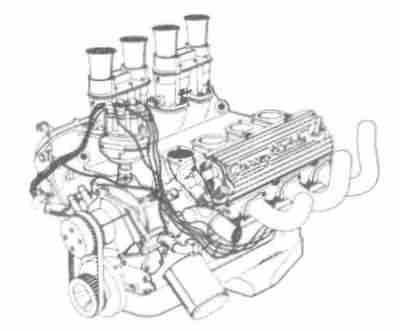 Dan Gurney commissioned British engine designer Harry Weslake to come up with
some new cylinder heads for the small, light 302 Ford engine. The Weslake
aluminum heads bolted to a stock 302 block and were operated by conventional
pushrods, making the resulting engine physically much smaller and lighter than
overhead cam engines of the same displacement. Note the steeply downdrafted
intake ports - the carburetors are sitting directly on the head with no
separate intake manifold.
Dan Gurney commissioned British engine designer Harry Weslake to come up with
some new cylinder heads for the small, light 302 Ford engine. The Weslake
aluminum heads bolted to a stock 302 block and were operated by conventional
pushrods, making the resulting engine physically much smaller and lighter than
overhead cam engines of the same displacement. Note the steeply downdrafted
intake ports - the carburetors are sitting directly on the head with no
separate intake manifold.
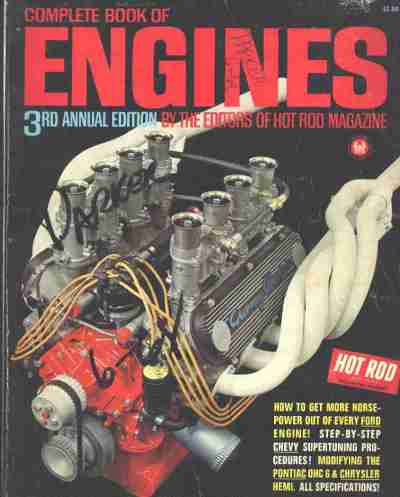 The Webers and stock type distributor indicate this is a very early Gurney-
Weslake engine. Note the separate valley cover, modified timing cover,
extra coolant hoses directing water directly to the exhaust ports, T-sump
steel oil pan, 289 or BOSS 302 style harmonic balancer, and the unimposing
stock Ford ignition coil. The -4 AN braided line connecting the heads is for
oiling the rocker shafts. The timing cover is a late 289 with the aluminum
pump. Note the safety wired bolts, timing belt drive to the water pump, and
the way the Weslake heads take water off at the beginning, center, and ends.
Wouldn't one of these look good in your car?
The Webers and stock type distributor indicate this is a very early Gurney-
Weslake engine. Note the separate valley cover, modified timing cover,
extra coolant hoses directing water directly to the exhaust ports, T-sump
steel oil pan, 289 or BOSS 302 style harmonic balancer, and the unimposing
stock Ford ignition coil. The -4 AN braided line connecting the heads is for
oiling the rocker shafts. The timing cover is a late 289 with the aluminum
pump. Note the safety wired bolts, timing belt drive to the water pump, and
the way the Weslake heads take water off at the beginning, center, and ends.
Wouldn't one of these look good in your car?
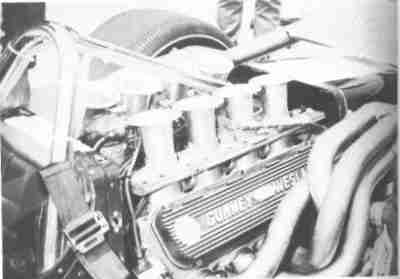 Dan Gurney's Eagle with took second place at Indy in 1968. Note the slide
valve throttles for the Lucas fuel injection and the magneto ignition. The
$14,000 engine made 535 HP at 7,800 RPM on 10% nitro for qualifying and
slightly over 500 HP on straight alcohol. This comparable to the exotic
DOHC Ford Indy V8s, only the Gurney engine was smaller, lighter, and much less
expensive.
Dan Gurney's Eagle with took second place at Indy in 1968. Note the slide
valve throttles for the Lucas fuel injection and the magneto ignition. The
$14,000 engine made 535 HP at 7,800 RPM on 10% nitro for qualifying and
slightly over 500 HP on straight alcohol. This comparable to the exotic
DOHC Ford Indy V8s, only the Gurney engine was smaller, lighter, and much less
expensive.
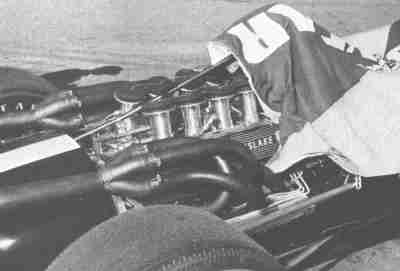 Gurney-Weslake in Indy car, circa 1969. These engines used ordinary hot rod
parts inside - Carillo rods, ForgedTrue pistons, etc. The turbo Offy and Ford
DOHC improved enough between the 1968 qnd 1969 seasons to make the stock block
Gurney-Weslake uncompetitive in normally aspirated form.
Gurney-Weslake in Indy car, circa 1969. These engines used ordinary hot rod
parts inside - Carillo rods, ForgedTrue pistons, etc. The turbo Offy and Ford
DOHC improved enough between the 1968 qnd 1969 seasons to make the stock block
Gurney-Weslake uncompetitive in normally aspirated form.
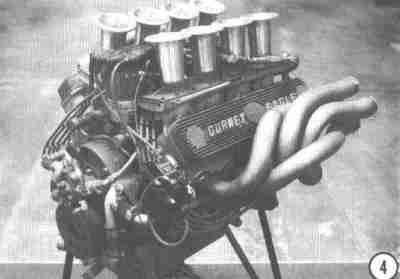 Later slide-throttle engines made over 600 HP. Note custom timing cover and
harmonic balancer, revised coolant path.
Later slide-throttle engines made over 600 HP. Note custom timing cover and
harmonic balancer, revised coolant path.
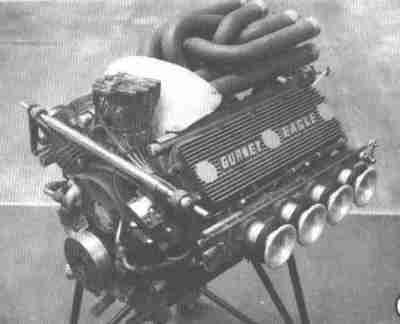 The last hurrah was the Gurney-Eagle with revised heads featuring three valves
per cylinder and reversed ports like the Ford DOHC Indy engine. It was
designed by John Miller of All American Racers.
The last hurrah was the Gurney-Eagle with revised heads featuring three valves
per cylinder and reversed ports like the Ford DOHC Indy engine. It was
designed by John Miller of All American Racers.
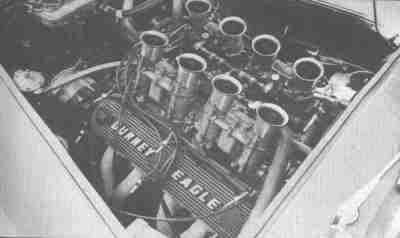 Dan Gurney originally intended to market the Weslake heads
widely through the aftermarket. Not many were made and the $2000 or so for
the heads (not to mention the required quartet of Weber downdrafts) made them
a expensive. Just as a guideline, you could buy a new Mustang for the price
of a complete Gurney-Weslake conversion.
Dan Gurney originally intended to market the Weslake heads
widely through the aftermarket. Not many were made and the $2000 or so for
the heads (not to mention the required quartet of Weber downdrafts) made them
a expensive. Just as a guideline, you could buy a new Mustang for the price
of a complete Gurney-Weslake conversion.
Some of the Gurney-Weslake heads made it to the street; here's a pair in a 289
Cobra.
 Dan Gurney commissioned British engine designer Harry Weslake to come up with
some new cylinder heads for the small, light 302 Ford engine. The Weslake
aluminum heads bolted to a stock 302 block and were operated by conventional
pushrods, making the resulting engine physically much smaller and lighter than
overhead cam engines of the same displacement. Note the steeply downdrafted
intake ports - the carburetors are sitting directly on the head with no
separate intake manifold.
Dan Gurney commissioned British engine designer Harry Weslake to come up with
some new cylinder heads for the small, light 302 Ford engine. The Weslake
aluminum heads bolted to a stock 302 block and were operated by conventional
pushrods, making the resulting engine physically much smaller and lighter than
overhead cam engines of the same displacement. Note the steeply downdrafted
intake ports - the carburetors are sitting directly on the head with no
separate intake manifold.
 The Webers and stock type distributor indicate this is a very early Gurney-
Weslake engine. Note the separate valley cover, modified timing cover,
extra coolant hoses directing water directly to the exhaust ports, T-sump
steel oil pan, 289 or BOSS 302 style harmonic balancer, and the unimposing
stock Ford ignition coil. The -4 AN braided line connecting the heads is for
oiling the rocker shafts. The timing cover is a late 289 with the aluminum
pump. Note the safety wired bolts, timing belt drive to the water pump, and
the way the Weslake heads take water off at the beginning, center, and ends.
Wouldn't one of these look good in your car?
The Webers and stock type distributor indicate this is a very early Gurney-
Weslake engine. Note the separate valley cover, modified timing cover,
extra coolant hoses directing water directly to the exhaust ports, T-sump
steel oil pan, 289 or BOSS 302 style harmonic balancer, and the unimposing
stock Ford ignition coil. The -4 AN braided line connecting the heads is for
oiling the rocker shafts. The timing cover is a late 289 with the aluminum
pump. Note the safety wired bolts, timing belt drive to the water pump, and
the way the Weslake heads take water off at the beginning, center, and ends.
Wouldn't one of these look good in your car?
 Dan Gurney's Eagle with took second place at Indy in 1968. Note the slide
valve throttles for the Lucas fuel injection and the magneto ignition. The
$14,000 engine made 535 HP at 7,800 RPM on 10% nitro for qualifying and
slightly over 500 HP on straight alcohol. This comparable to the exotic
DOHC Ford Indy V8s, only the Gurney engine was smaller, lighter, and much less
expensive.
Dan Gurney's Eagle with took second place at Indy in 1968. Note the slide
valve throttles for the Lucas fuel injection and the magneto ignition. The
$14,000 engine made 535 HP at 7,800 RPM on 10% nitro for qualifying and
slightly over 500 HP on straight alcohol. This comparable to the exotic
DOHC Ford Indy V8s, only the Gurney engine was smaller, lighter, and much less
expensive.
 Gurney-Weslake in Indy car, circa 1969. These engines used ordinary hot rod
parts inside - Carillo rods, ForgedTrue pistons, etc. The turbo Offy and Ford
DOHC improved enough between the 1968 qnd 1969 seasons to make the stock block
Gurney-Weslake uncompetitive in normally aspirated form.
Gurney-Weslake in Indy car, circa 1969. These engines used ordinary hot rod
parts inside - Carillo rods, ForgedTrue pistons, etc. The turbo Offy and Ford
DOHC improved enough between the 1968 qnd 1969 seasons to make the stock block
Gurney-Weslake uncompetitive in normally aspirated form.
 Later slide-throttle engines made over 600 HP. Note custom timing cover and
harmonic balancer, revised coolant path.
Later slide-throttle engines made over 600 HP. Note custom timing cover and
harmonic balancer, revised coolant path.
 The last hurrah was the Gurney-Eagle with revised heads featuring three valves
per cylinder and reversed ports like the Ford DOHC Indy engine. It was
designed by John Miller of All American Racers.
The last hurrah was the Gurney-Eagle with revised heads featuring three valves
per cylinder and reversed ports like the Ford DOHC Indy engine. It was
designed by John Miller of All American Racers.
 Dan Gurney originally intended to market the Weslake heads
widely through the aftermarket. Not many were made and the $2000 or so for
the heads (not to mention the required quartet of Weber downdrafts) made them
a expensive. Just as a guideline, you could buy a new Mustang for the price
of a complete Gurney-Weslake conversion.
Dan Gurney originally intended to market the Weslake heads
widely through the aftermarket. Not many were made and the $2000 or so for
the heads (not to mention the required quartet of Weber downdrafts) made them
a expensive. Just as a guideline, you could buy a new Mustang for the price
of a complete Gurney-Weslake conversion.